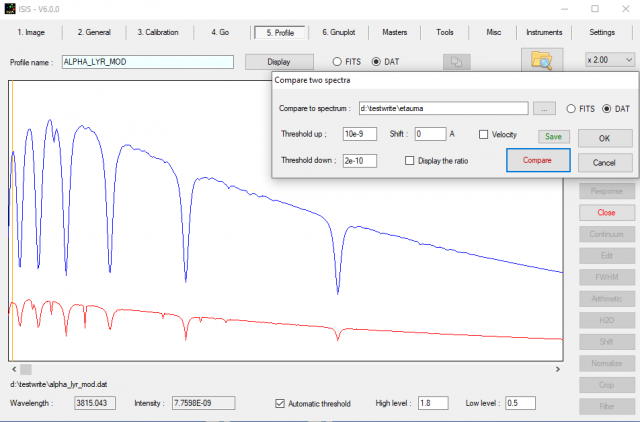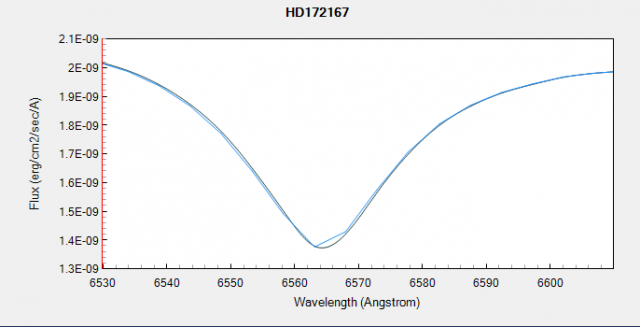› Forums › Spectroscopy › CALSPEC reference spectra
- This topic has 6 replies, 3 voices, and was last updated 4 years, 12 months ago by
 Dr Andrew Smith.
Dr Andrew Smith.
-
AuthorPosts
-
9 December 2020 at 9:09 pm #574822
 Dr Andrew SmithParticipant
Dr Andrew SmithParticipantDavid Boyd proposes using the HST CALSPEC calibrated absolute flux spectra for converting relative intensity to FLAM units.
I have written a python program to take the CALSPEC .fits tables and saves the flux v wavelength in a format ISIS can read.
This data might be useful to other so I was wondering what wavelength range would be needed to cover the range of amateur spectrographs. Looking at the UVEX & IR Lisa does 3400 to 1000 A seem right?
Could the data be hosted on the BAA site?
Regards Andrew
PS Here is a sample ( if only my spectra looked like these).

Attachments:
10 December 2020 at 12:07 pm #583514 David BoydParticipant
David BoydParticipantHi Andrew,
Thanks, that will be useful. The CALSPEC files at STScI are Multi-Extension FITS files and can’t be read by ISIS. I had the same problem reading files in NGSL and also wrote a Python script to turn them into Basic FITS files.
The range of the commonly used BVRI Johnson-Cousins filter passbands is from about 3600 A to 9750A in case anyone wants to use the CALSPEC files to calibrate flux for the other filters.
The UVEX claims to cover the range from 3500 A to 10,000 A and the upper limit of the LISA IR version is also 10,000 A so the range you suggest looks good.
Probably the best place to put it on the BAA website would be in the Equipment & Techniques Section webpage on Spectroscopy.
If you ask David Arditti he can put it there.
David
10 December 2020 at 12:15 pm #583515 Andy WilsonKeymaster
Andy WilsonKeymasterHi Andrew,
I agree this sounds useful, thank you.
I may be the person who helps to get these onto the website, so my initial thoughts are about what the files are like. Are there one or many, and what file type are they?
The E&T pages sound like a useful place to put these, although the Drupal software on which the website is based can sometimes make things like this a little tricky. They might need to go in the Publications->Downloads->Sections->E&T area of the website. A backup plan would be to put them on the BAA Spectroscopy Database pages, though the main website would be better as long as it doesn’t get too messy.
Best wishes,
Andy
10 December 2020 at 12:54 pm #583516 Dr Andrew SmithParticipant
Dr Andrew SmithParticipantHi Andy – I think less than 60 files (20 or so if restricted to A or B stars). I am putting them in text files in the ISIS .dat format ( wavelength flux) so far the are all under 9,800 KB the names are as in the CALSPEC catalogue https://www.stsci.edu/hst/instrumentation/reference-data-for-calibration-and-tools/astronomical-catalogs/calspec .
I could put them in fits format but I am not sure (need to test) if that would require me to resample them to a fixed wavelength interval and I would rather not change the data.
Regards Andrew
10 December 2020 at 1:21 pm #583518 Andy WilsonKeymaster
Andy WilsonKeymasterHi Andrew,
In that case it would be best to create a zip containing everything, or a choice of zip and another compression format.
It is easy to add one or two files, but each file requires its own download page, hence it makes sense to have a single file with everything. It will also be easier for people to download a single file.
Best wishes,
Andy
15 December 2020 at 1:36 pm #583519 Dr Andrew SmithParticipant
Dr Andrew SmithParticipantWhat I will do is do two zip files one with everything (may not do the NGC entries) and one with just A & B stars. It will take a few days to do the all!
Regards Andrew
PS Just did them all in the end as it was simpler.
15 December 2020 at 1:41 pm #583571 Dr Andrew SmithParticipant
Dr Andrew SmithParticipantI have converted the STScI Calspec spectra from there original fit table format to a “flat” fits format that can be read by BassProject and ISIS. One or two obscure spectra did not convert. I have included some notes (with spelling mistakes) and a Excel catalogue culled from the two on the Calspec site.
I have sent a copy of the 20.5 Mb zip file to Andy to consider making it available from the BAA web site.
I eyeballed all the spectra and checked a small random sample against the originals using Tim Lester’s PlotSpectra which can display the original along side the converted ones.
Here is a comparison of the original and converted spectra of Alpha Lyr. Black is converted blue original.

I anyone needs it now I am happy to email it to you.
Regards Andrew
-
AuthorPosts
- You must be logged in to reply to this topic.
